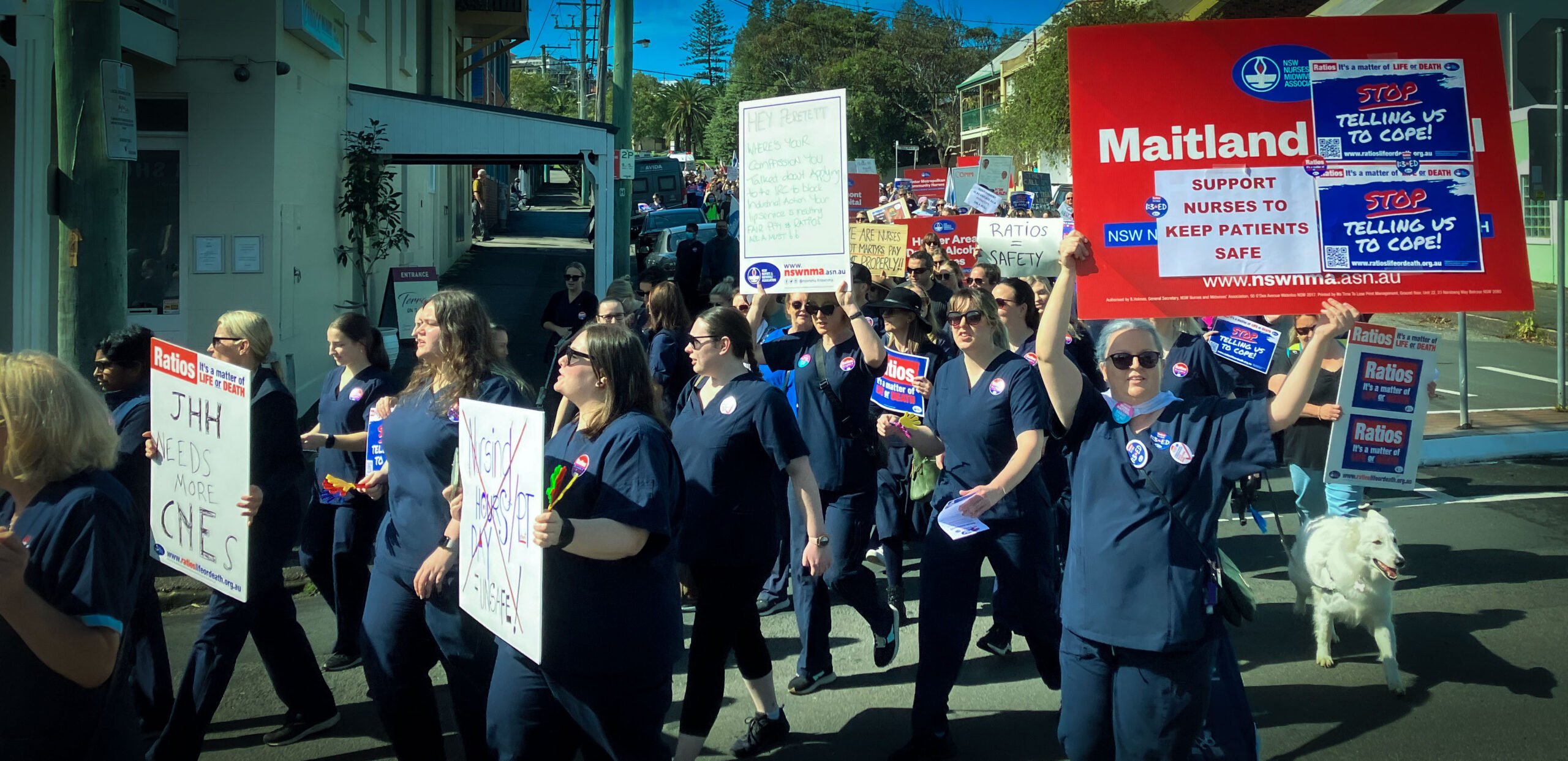Changes are retrospective.
The amendments below apply to all existing claims. Further details regarding implementation can be found in the Unions NSW update called Implementation of the Workers Comp Laws.
Weekly payments
0-130 weeks (2.5 years)
For the first 13 weeks after an injury, workers will receive 95% of their pre-injury average weekly earnings (minus any wages earned and non-pecuniary benefits, up to $1838.70 per week).
At 14 weeks, weekly payments will be reduced to:
- 80% of pre-injury average weekly earnings if the injured worker has not had a work capacity assessment or is working less than 15 hours a week; or
- 95% of pre-injury average weekly earnings if the injured worker has returned to work for 15 hours or more per week.
At 52 weeks, weekly payments will be reduced to:
- 80% of pre-injury average weekly earnings (excluding overtime or shift allowances) if the injured worker has not had a work capacity assessment or is working less than 15 hours a week; or
- 95% of pre-injury average weekly earnings (excluding overtime or shift allowances) if the injured worker has returned to work for 15 hours or more per week.
130 weeks (2.5 years) – 5 years
After 130 weeks injured workers will only receive payments if:
- they have no work capacity and this is likely to continue indefinitely or;
- they:
- have applied for continuation one year before payments were due to end;
- work 15 hours a week or more;
- are being paid at least $155 a week; and
- have been assessed as likely to continue to be indefinitely incapable of extra employment or higher pay.
If they meet this test, the injured worker must receive a work capacity test at least every two years.
If the injured worker is eligible to receive payments after 130 weeks, they will continue to be paid at the rate they received during the 52-130 week period.
After 5 years
An injured worker must have a 20% Whole Person Impairment (WPI) to continue weekly payments after 5 years.
For example:
- WPI less than 20% – losing an eye or single spinal fusion;
- WPI between 20% and 30% – losing most, but not all of a limb.
Calculation of weekly benefits
Pre-injury average weekly earnings, referred to above, are calculated at the injured worker’s ordinary earnings plus overtime and shift allowances, averaged over the previous 52 weeks.
This definition excludes periods of unpaid leave and includes the value of non-pecuniary benefits. Non-pecuniary benefits include residential accommodation, use of motor vehicle, health insurance and education fees.
Calculations that include overtime and shift allowances will only be paid for the first year. Other allowances, other than shift allowances that may have been paid in the previous 52 weeks, are not included in the calculation.
Calculations may reduce the amount of weekly benefits by the amount of suitable employment the worker has been certified as being able to perform, whether they are actually receiving any employment income or not. This will need to be tested as the new legislation comes into operation.
While the Act excludes periods of unpaid leave in the calculation of pre-injury average weekly earnings, it does not make reference to periods of paid parental leave under the Federal Government’s scheme, leading to uncertainty about how this will be dealt with.
Cover during travel retained in limited form
Workers injured when travelling to or from work are only covered “if there is a real and substantial connection between the employment and the accident or incident out of which the personal injury arose”.
This change will create great uncertainty over which journeys will be covered. Disputes will most likely arise around proving the ‘connection’ between an accident and work, which will need to be tested in the Workers Compensation Commission (the Commission). Because the cost burden of paying for such proceedings now falls on injured workers, it is likely that injured workers will be reluctant to pursue such disputes.
This approach to journey claims is similar to the South Australian model. Unions NSW will be looking into South Australian cases to assess the circumstances under which a journey claims can now be made.
Cuts to cover for medical expenses
Medical and other expenses related to an injury will only be paid for one year after an injury, or one year after weekly payments cease, whichever is longer. If an injured worker is no longer receiving weekly payments, but then later returns to receiving weekly payments, their medical costs are again paid, but only for the time they are receiving weekly payments.
Only workers who have a 30% WPI will be exempt from these medical caps. Examples of 30% or more WPI include:
- loss of an entire limb;
- compression fracture to the cervical spine; or
- bilateral shoulder reconstructions with a poor outcome.
Medical costs will only be paid if they have prior approval from the insurer. This does not include treatment provided in the first 48 hours after the injury or treatments and services that are exempt from prior approval by WorkCover.
There is no payment for travel expenses for medical appointments if the location is further than ‘reasonably necessary’. Medical expenses will only be covered in regard to what is ‘reasonably appropriate’ rather than in regard to the ‘customary charge’.
WorkCover guidelines may also make further restrictions on which medical bills are and are not payable. WorkCover can fix a maximum payable amount for any particular medical or related treatment.
Work Capacity Assessment
A ‘work capacity assessment’ is conducted by the insurer in accordance with WorkCover guidelines.
Work capacity decisions are made by the insurer and it is expected the decision will be informed by a work capacity assessment. However, the insurer can make a ‘work capacity decision’ without a work capacity assessment. Work capacity decisions relate to:
- Current work capacity;
- Suitable employment;
- Wages for suitable employment;
- Pre-injury average weekly earnings;
- Any decision regarding the entitlement to weekly payments including suspension, discontinuance and reduction.
Work capacity decisions do not include questions of liability. The Commission has no jurisdiction about work capacity decisions.
Injured workers are not entitled to refuse to attend a work capacity assessment arranged by the insurer and failure to attend will lead to automatic suspension of weekly payments. An insurer can conduct a work capacity assessment at any time and they decide who conducts the work capacity assessment.
If an injured worker is unhappy with a work capacity decision the following review process applies.
- They must ask the insurer for an internal review within 30 days.
- If they are still unhappy, the injured worker can ask WorkCover to review the decision.
- If they are still unhappy, the injured worker can ask the Independent Review Officer (IRO) to review the decision. The recommendation of the IRO is binding.
- If they are still unhappy there is the ability to appeal to the Supreme Court.
Even if an injured worker is following the above process to try and change a work capacity decision, the decision is still implemented while the review process goes ahead.
A lawyer acting for an injured worker is not entitled to be paid or recover any amount for costs incurred in connection with a review of a work capacity decision.
Independent Review Officers
A new position of Independent Review Officer (IRO) has been created. The functions of this position are:
- Deal with complaints made to them.
- Review work capacity decisions.
- Inquire into and report to the Minister on matters arising out of the Workers Compensation Act that the IRO considers are appropriate.
- Encourage the establishment by insurers and employers of complaint resolution processes.
- Other functions as conferred by legislation. Injured workers can make complaints to the IRO about any act or omission of an insurer that affects the entitlements, rights or obligations of the worker.
Legal costs
When appearing before the Commission, each party must bear their own costs. The Commission does not have the power to order the payments of costs. This does not apply to proceedings commenced before the commencement of the amendment.
Limits on lump sums for injury, commutation and work injury damages
Lump sum payments are only available for serious permanent injuries, which are defined as greater than 10% WPI. Lump sum payments for pain and suffering have been removed. The requirement for workers to have received legal advice before entering into an agreement for a lump sum payment has been removed. Instead, the insurer or employer must be satisfied the worker has waived this right.
Only one assessment of claims of permanent impairment is allowed for all permanent impairment, commutation or work injury damages claims.
The requirement for the worker to get independent legal advice before making decisions regarding commutations has been watered down by allowing the injured worker to waive this requirement. The regulations are expected to include a requirement that an injured worker gain financial advice (paid for by the insurer) before agreeing to a commutation.
Limits on claims for strokes and heart attacks
Heart attacks, strokes and injuries relating to these will not be covered unless the nature of the employment gave rise to ‘significantly greater risk’.
Restrictions on cover for occupational disease
The definition of ‘injury’ has been amended so that a disease is only covered if the employment was the main contributing factor to contracting the disease or the aggravation, acceleration, exacerbation or deterioration of the disease.
This will arguably lead to a large group of injured workers no longer eligible to make claims and will also lead to potential disputes. Similar to journey claims, the testing of these disputes will be limited as a result of the legal cost financial burden placed on injured workers when appearing before the Commission.
Partner’s claims for nervous shock abolished
There is no longer a right for relatives of workers killed or injured at work to claim nervous shock. Claims for nervous shock can be made if it is a work injury; however claims by relatives are defined as not being work injuries.
Return to work
Obligations on the injured worker to return to work have been increased and expanded. They must make reasonable efforts to return to employment or pre-injury employment at their place of employment or another place of employment. A reasonable effort is defined to include waiting for workplace rehabilitation to commence or waiting for a response to a request for suitable employment.
If the injured worker does not comply, the insurer may suspend, terminate or cease and determine weekly payments.
If the employer does not comply with their obligation to provide suitable work, they may receive a maximum of 50 penalty units. An employer can be issued an improvement notice by an inspector for contravening their return to work obligations. If the employer issued the improvement notice does not comply, they may receive a maximum of 100 penalty units.
Exemptions
The amendments do not apply to police officers, paramedics, firefighters, coalminers or someone covered by the Workers Compensation (Bush Fire, Emergency and Rescue Services) Act 1987.
Review
A review will take place 2 years from the assent of the amending Act. This review will seek to determine whether the Act has achieved its policy objectives. If the Minister determines on actuarial advice that the scheme is projected to return to surplus before the end of the two years, a review is to be undertaken as soon as possible after the projected date.







